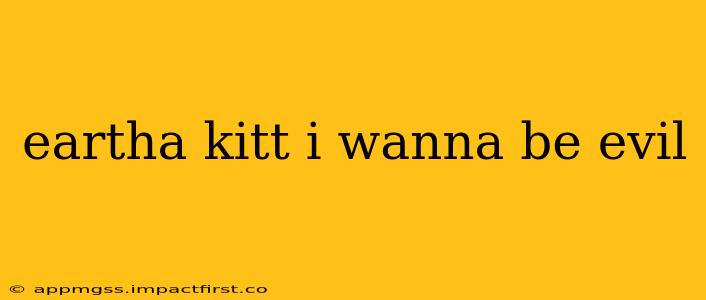Eartha Kitt's sultry rendition of "I Wanna Be Evil" isn't just a song; it's a cultural phenomenon. This captivating tune, with its playful wickedness and undeniable charisma, has cemented its place in musical history, captivating audiences for decades. But what makes this song so enduringly popular? Let's explore the depths of this feline-esque masterpiece, examining its origins, impact, and lasting legacy.
What is the song "I Wanna Be Evil" about?
"I Wanna Be Evil" is a playful exploration of embracing one's darker side. It's not about outright malice; rather, it's about the seductive allure of mischief and the liberating feeling of shedding societal constraints. The lyrics depict a character relishing the freedom and power associated with a less-than-virtuous persona, acknowledging the inherent fun in being a little bit naughty. It's a celebration of individuality and a rejection of conformity, expressed through a darkly comedic lens.
Who wrote "I Wanna Be Evil"?
The music for "I Wanna Be Evil" was composed by Henry Mancini, the celebrated composer known for his work on films like "Breakfast at Tiffany's" and "The Pink Panther." The lyrics were penned by the equally talented Johnny Mercer, a legendary songwriter responsible for countless hits. This powerful creative duo perfectly captured the song's unique blend of sophistication and playful naughtiness.
When was "I Wanna Be Evil" released?
The song was originally released in 1960 as part of the musical "Shinbone Alley," but it was Eartha Kitt's unforgettable 1961 recording that propelled it to fame. Kitt's interpretation perfectly embodied the song's essence, transforming it into an iconic piece of pop culture.
What makes Eartha Kitt's version so iconic?
Eartha Kitt's performance of "I Wanna Be Evil" is legendary. Her unique vocal style, characterized by its smoky tone and playful purr, perfectly complemented the song's mischievous lyrics. Her stage presence and inherent charisma further elevated the song, transforming it from a simple tune into a mesmerizing performance. The combination of Kitt's talent and the song's inherently catchy melody created a perfect storm of musical magic.
What other artists have covered "I Wanna Be Evil"?
While Eartha Kitt's version remains the most famous, "I Wanna Be Evil" has been covered by several artists over the years. These interpretations offer different perspectives on the song, highlighting its versatility and enduring appeal across genres and generations. The variations in vocal style and musical arrangement underscore the song's adaptability and its capacity to resonate with diverse audiences.
What is the legacy of "I Wanna Be Evil"?
"I Wanna Be Evil" remains a staple in pop culture, frequently appearing in films, television shows, and theatrical productions. Its enduring popularity speaks to its timeless appeal and its ability to connect with audiences across generations. The song's playful exploration of mischief and its celebration of individuality continue to resonate, making it a relevant and engaging piece of musical history. Its association with Eartha Kitt further solidifies its status as a classic.
Is "I Wanna Be Evil" a villain song?
While the song centers on the desire to "be evil," it’s crucial to understand the context. It’s not a celebration of true villainy, but rather a playful exploration of embracing a persona that defies convention and expectations. The "evil" portrayed is more of a mischievous, seductive rebellion than genuine malice. It's a fun, flirtatious expression of self-discovery, not a call to arms for nefarious deeds.
This exploration into Eartha Kitt's "I Wanna Be Evil" reveals more than just a song; it's a testament to the power of performance, the enduring appeal of a catchy tune, and the captivating mystique of Eartha Kitt herself. The song’s continued relevance highlights its exploration of themes that remain pertinent in contemporary society – self-expression, individuality, and the playful embrace of one's inner rebel.
